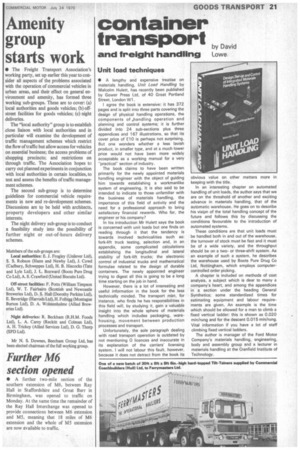container
Page 23

If you've noticed an error in this article please click here to report it so we can fix it.
transport by David and freight handling Lowe
Unit load techniques
• A lengthy and expensive treatise on materials handling, Unit Load Handling by Malcolm Hulett, has recently been published by Gower Press Ltd, of 40 Great Portland Street, London W1.
I agree the book is extensive: it has 372 pages and is split into three parts covering the design of physical handling operations, the components of ,,handling operation and planning and control systems; it is further divided into 24 sub-sections plus three appendices and 167 illustrations, so that its cover price of £10 is perhaps not surprising. But one wonders whether a less lavish product, in smaller type, and at a much lower price would not have been more widely acceptable as a working manual for a very "practical" section of industry, The book claims to have been written primarily for the newly appointed materials handling engineer with the object of guiding him towards establishing a workmanlike system of engineering. It is also said to be intended to indicate to those unfamiliar with the business of materials handling, the importance of this field of activity and the need for a professional approach to bring satisfactory financial rewards. Who for, the engineer or his company?
In his introduction Mr Hulett says the book is concerned with unit loads but one finds on reading through it that the tendency is towards involved technicalities such as: fork-lift truck testing, selection and, in an appendix, some complicated calculations establishing the longitudinal and lateral stability of fork-lift trucks; the electronic control of industrial trucks and mathematical formulae related to the design of durable containers. The newly appointed engineer trying to digest all this is going to be a long time starting on the job in hand.
However, there is a lot of interesting and useful information in the book for the less technically minded. The transport man, for instance, who finds he has responsibilities in this field will, by studying it, gain a valuable insight into the whole sphere of materials handling which includes packaging, warehousing, movement between production processes and transport.
Unfortunately, the sole paragraph dealing with road transport operation is outdated by not mentioning 0 licences and inaccurate in its explanation of the carriers' licensing system. I will not labour this fault, however, because it does not detract from the book its obvious value on other matters more in keeping with the title.
In an interesting chapter on automated handling of unit loads, the author says that we are on the threshold of another and exciting advance in materials handling, that of the automatic warehouse. He goes on to describe his vision of the total handling concept of the future and follows this by discussing the conditions favourable to the introduction of automated systems.
These conditions are that unit loads must be handled both in and out of the warehouse, the turnover of stock must be fast and it must be of a wide variety, and the throughput should be on a twoor three-shift system. As an example of such a system, he describes the warehouse used by Boots Pure Drug Co Ltd, Nottingham, which employs computercontrolled order picking.
A chapter is included on methods of cost analysis, a subject which is dear to many a company's heart, and among the appendices in a section under the heading General Synthetics: some standardized times for estimating equipment and labour requirements are given. An example is the time which should be allowed for a man to climb a fixed vertical ladder: this is shown as 0.020 min/rung and for the descent 0.015 min/rung. Vital information if you have a lot of staff climbing fixed vertical ladders.
The author is manager of the Ford Motor Company's materials handling, engineering, body and assembly group and a lecturer in materials handling at the Cranfield Institute of Technology.























